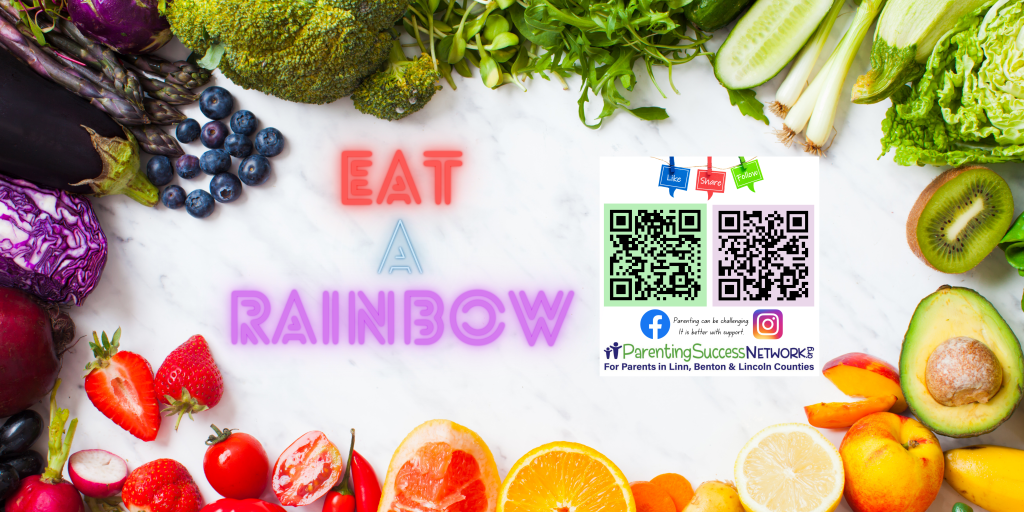Eat a Rainbow
 Have you ever wondered why we are encouraged to add colorful foods to our plates and “eat a rainbow”? As National Nutrition Month wraps up, let’s dig into the benefits of ‘eating a rainbow.’
Have you ever wondered why we are encouraged to add colorful foods to our plates and “eat a rainbow”? As National Nutrition Month wraps up, let’s dig into the benefits of ‘eating a rainbow.’
The suggestion that we eat a rainbow is not literal – it just means to have lots of different colors on your plate at mealtime, like red tomatoes and green beans, purple eggplant and blueberries.
Why Eat a Rainbow?
Nutritionists have identified many benefits to incorporating colorful plants into your family’s diet.
Plant foods, like fruits, vegetables, and grains, contain naturally occurring chemicals called phytonutrients. Phytonutrients protect the plant from disease; when we eat them, they help protect our bodies.
Says Katherine D. McManus, Director for Nutrition at Dana Farber Cancer Institute, “When humans eat plant foods, phytonutrients protect us from chronic diseases.
“Phytonutrients have potent anti-cancer and anti-heart disease effects. And epidemiological research suggests that food patterns that include fruits and vegetables are associated with a reduced risk of many chronic diseases, including cardiovascular disease, and may be protective against certain types of cancers.
“The American Cancer Society recommends 2-1/2 cups per day of fruits and vegetables. The most recent US Dietary Guidelines recommend consuming even more: 2-1/2 cups of vegetables and 2 cups of fruit, based on a 2,000-calorie diet.”
When you include colorful foods in your family meals, you bring a rich variety of beneficial phytonutrients to the table.
What Does Each Color Bring to the Table?
Harvard Health summarizes the phytonutrients represented in various colors, and the foods they can be found in. The more colorful your plate, the more health benefits you get.
Red indicates the presence of lycopene, a carotenoid pigment that has antioxidant properties and seems to protect against prostate cancer and heart and lung disease.
Reach for: Apples, strawberries, cherries, raspberries, beets, red peppers, and watermelon, cranberries, tomatoes, red grapes, red peppers, red onions.
Orange and yellow signify beta-carotene, another carotenoid, which the body converts into vitamin A, according to MedlinePlus.
Reach for: Yellow or orange bell peppers, sweet potatoes, cantaloupe, carrots, oranges, bananas, pineapple, tangerines, mango, pumpkin, apricots, winter squash (butternut, acorn), peaches, and corn.
Green means a number of compounds that have been linked to a decreased risk of various cancers.
Reach for: Kale, spinach, broccoli, asparagus, kiwi, avocados, artichokes, alfalfa sprouts, cabbage, brussels sprouts, collard greens, green tea, and green herbs (mint, rosemary, sage, thyme, and basil).
Blue and purple, along with deep reds and black pigments, indicate the presence of anthocyanins, compounds with antioxidant properties that may help delay cellular aging and decrease the risk of blood clots.
Reach for: Blueberries, blackberries, elderberries, plums, eggplant, Concord grapes, raisins, figs, prunes, lavender, purple cabbage.
White and brown: The onion family contains allicin, which has anti-tumor properties. Other foods in this group contain antioxidant flavonoids like quercetin and kaempferol.
Reach for: onions, cauliflower, garlic, leeks, parsnips, daikon radish, and mushrooms.
So go ahead and eat a rainbow every day. When you fill your plate with colorful foods, you fill your body with phytonutrients that can help keep you healthy.